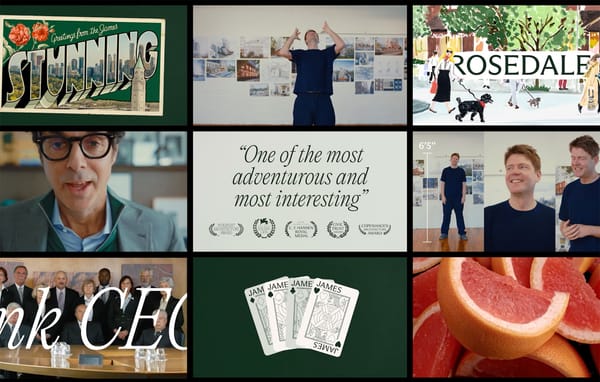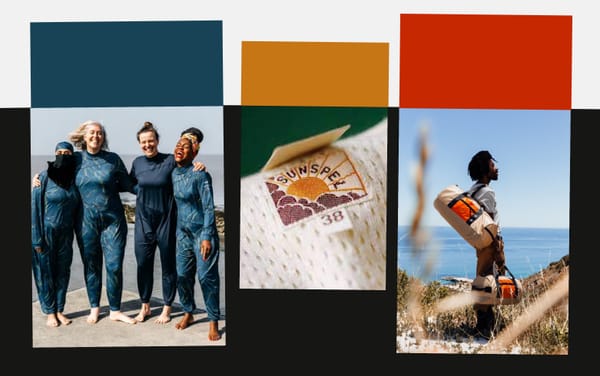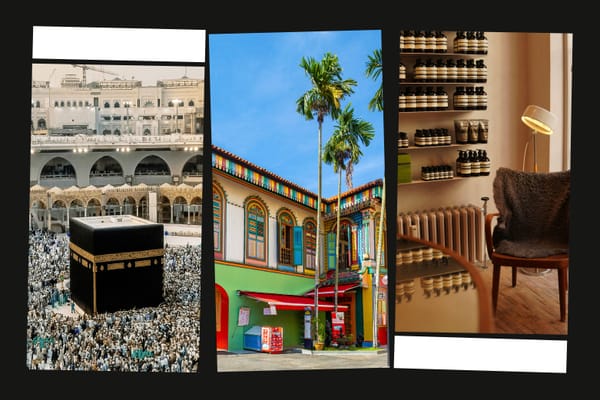Artist, DJ, and writer Jace Clayton on optimism and the power of communal experiences
On making music in clubs, presenting art in museums, and nurturing the next generation
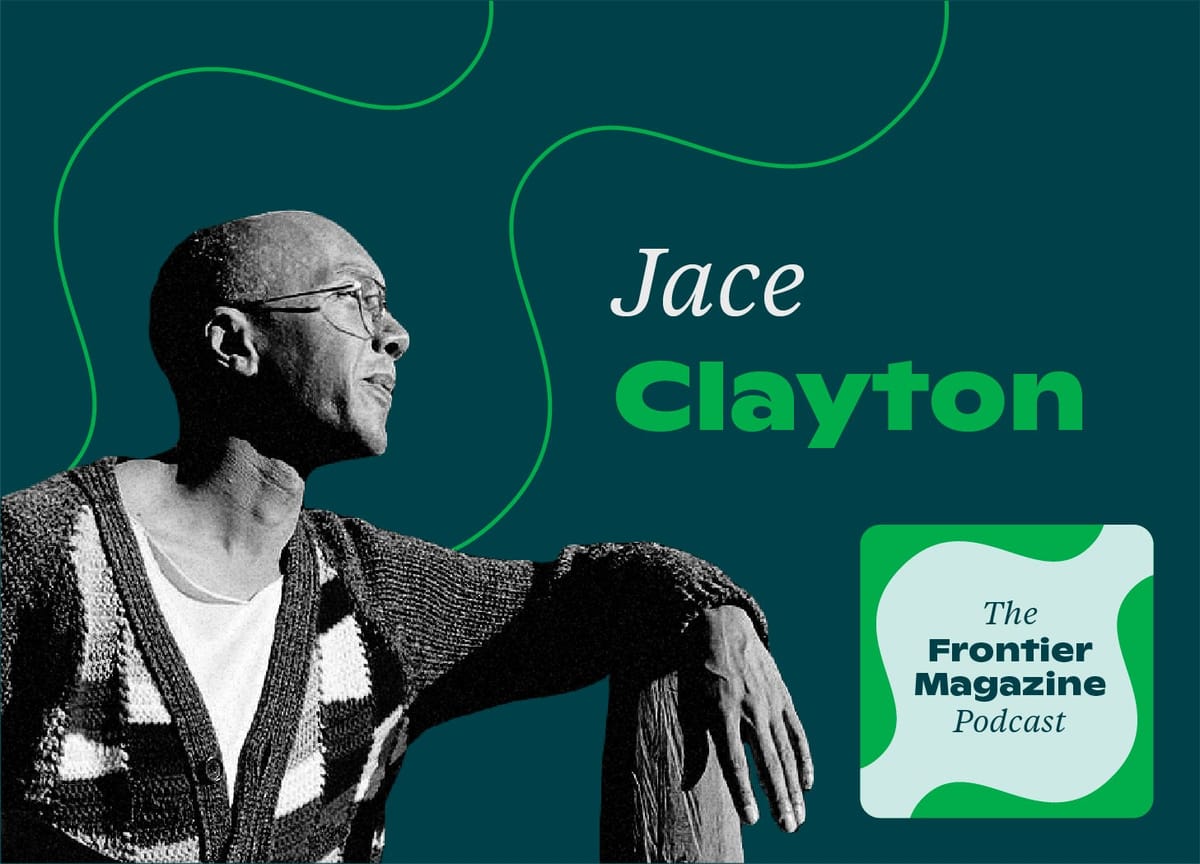
Episode Transcript
Jace Clayton: I think now, especially post-Bandcamp, we’re like, “Ohhhh, we need more distribution networks. We need more lines of communication.” Stuff is getting made in all sorts of ways. But then there is this very basic question: how do you find the good stuff?
And most listeners don’t care about musicians, that’s why people pay money to Spotify. Fine. I’d like them to admit it: if you subscribe to Spotify, you don’t give a bleep about musicians. But if you do care—if you’re thinking, “Oh, maybe my participation in this could be more active or could be more conscientious or creator-friendly,” then it’s a totally fascinating moment. “Okay, what next?”
Brian Sholis: I’m Brian Sholis, and this is the Frontier Magazine Podcast, where I interview artists, writers, technologists, architects, and other creative people about their work and the ideas and ideals that inspire it.
Today I’m speaking with Jace Clayton. I first encountered his work, as so many people did, in 2001: that year, under the name DJ /rupture, he released Gold Teeth Thief, an hourlong three-turntable mix that blended Missy Elliott and the Wu-Tang Clan with tracks from the Caribbean, North Africa, and the Middle East—and occasionally warped them into passages of ecstatic noise. As it did for many others, Gold Teeth Thief opened me up to a wider world of sound and sent me down mp3 blog rabbit holes. I began following Clayton’s blog, Mudd Up!, and listening to his radio show of the same name.
In 2016, Clayton published Uproot, a fantastic and far-seeing book chronicling his “travels in 21st-century music and culture,” and he has written about sound, art, and sound as art in the pages of Artforum, Frieze, and the wonderful online publication 4 Columns. Those pieces also sketch the sensibility behind his own artworks, which have been exhibited at the Harvard Art Museums, the Sharjah Biennial, the FRONT Triennial, and the MassArt Art Museum.
For more than two decades I’ve admired Clayton’s catholic-with-a-lowercase-c taste, his openness to new experiences, his desire to push his creative work in new directions, and his willingness to share with readers and listeners where he’s going, what he’s finding, what he’s doing with it, and why.
You can learn more about Frontier Magazine and subscribe at magazine.frontier.is. Thanks for listening. And now, my conversation with Jace Clayton.
Brian Sholis: Among other things, your book Uproot uses visits to far-flung local musical scenes to ask deep and prescient questions about technology and globalization. You write at one point that “experiencing the world via music or travel is supposed to be strange.” I’d love to begin by talking about how you experience that strangeness now, seven years after the book was published.
Jace Clayton: I feel like this is a COVID question. Everyone was stuck in place for a while and then, you know, we’re sort of moving out of that. But even so, live music performance, live participation in musical cultures, have been really damaged, it feels like. In the initial months after things sort of opened up, I was like, “Oh, everyone’s just going back to the same situation, as if everything is the same, even though it’s not.” And it felt like a lost opportunity to rethink what musical engagement with other people in real time could look like. I wanted things to get—to reconfigure a bit, you know?
I was thinking: What will this do to local music? Rather than see Taylor Swift come and fill the stadium—what if it’s like, “Oh, every week there are these musicians who come together and play in the space”—this kind of ongoing, more like, conversation. Things like that I’ve been hoping to see. And I feel like I have yet to see. Zooming out a bit, a lot of people would say, “Oh, this book is so optimistic about different types of networked technologies. And maybe it’s a corporate technology, but [the] grassroots use of it. And that optimism or excitement is certainly in place. But in a sense the situation is more grim [laughs] than it was back when I wrote the book. And precisely because I feel like so many of these technologies which could either open up a platform or work toward centralizing it and locking it down have worked toward the latter—towards centralization and to locking it down.
BS: What you say about these things being more locked down now than they were eight or ten years ago feels true to me. And yet I still hear a note of optimism in your voice. Even in the midst of the pandemic, you want these local cultures to flourish and you want people to discover them. So I’ll ask a little more directly: what is something exciting you’ve discovered in the cracks or the margins of these kinds of centralizing platforms? Or is it as bad as it can sometimes seem?
JC: [laughs] It’s so funny. How can I say this? You know, we’re talking now in the context of, like, Bandcamp [being] in the last stages of its life. So Bandcamp, the premiere independent platform for selling music and giving you wonderful and unprecedented levels of transparency and control and percentage rates: they just laid off half of their workforce, including, it seems, everyone who’s involved in the Bandcamp union. It’s deeply sad and it’s this moment of, “Wow, it’s not like an independent musical ecosystem. It’s one company. [Laughs] And that one company, you know, it’s been bought and then it’s been bought again. And now it’s on its last legs. And you’re like, ‘Oh, we didn’t have anything.’”
So, in a way, I think this particular conversation is in this moment of a crazy wake-up call. And that said, my optimism, it’s like, I’m not optimistic for musicians. Musicians have always had it hard, you know? We have always been underpaid and looked down upon like these weird avatars of a certain type of cool and fluidity and excitement. But at the end of the day, it’s a job that most people who try and do it are living on the edge with very few aspects of [laughs] lasting support. And that’s super real. But at the same time, and this will not be beaten out of me, I do believe in music and the experiences music offers as a kind of alternative precisely to the type of markets maybe best exemplified by like, the Spotifies of the world—purely violent, extractive markets. It’s a whole way of communicating and gathering together. And even thinking through memory that’s not primarily tethered to an economic exchange.
So it’s like nothing is outside of capitalism but music has this really weird place where it is this kind of dissonant yet resonant entity. Music has these qualities which are sort of intrinsic to the form—this openness, this plurality, this slipperiness, this fact that it is so hard to control—all these things, that’s where the little flames continue for me. And I’m like, “Oh, can different types of technological thinking or different types of network architectures reflect that?” That’s the open question that remains under answered.
The history of electronic music is the history of the creative misuse of existing technology.
BS: Perhaps we can refer to an early chapter in the book to frame that under-answered question. You write about the global spread of Auto-Tune circa 2000 to 2015, how it became braided with what were sometimes centuries-long cultural traditions. Are you seeing anything emerging now that seems like it may be as creatively fruitful and spread as rapidly as Auto-Tune did?
JC: I mean, not at the moment. Auto-Tune was so interesting, you know? This is the first music-making tool that was primarily digital. And that primary existed on the web. It was a software before it was a hardware box. So there was this kind of wonderful confluence of things that led to that very profound and wide-ranging creative effervescence around Auto-Tune. Now it’s easier and easier to make electronic music on your phone, things like that. And of course, different people [are] using AI and machine learning as a way of opening up certain creative portals.
I like to say the history of electronic music is the history of the creative misuse of existing technology. That’s how DJing began. People using machines in the wrong way, playing turntables wrong, getting the drum machine wrong, and then getting the bass synth wrong—and suddenly you have acid house. That’s always gonna go on. But the thing that made it really come into that pop visibility was, in a way, the specificity of the tool. People were just like, “What is that weird effect?” Whereas nowadays, I feel like there are more tools but perhaps [they’re] harder to recognize as such. They’re not calling attention to themselves in that way.
But it’s not that we need more tools. I think now, especially post-Bandcamp, we’re like, “Ohhhh, we need more distribution networks. We need more lines of communication.” Stuff is getting made in all sorts of ways. But then there is this very basic question: how do you find the good stuff?
And most listeners don’t care about musicians, that’s why people pay money to Spotify. Fine. I’d like them to at least admit it: if you subscribe to Spotify, you don’t give a bleep about musicians. But if you do care—if you’re thinking, “Oh, maybe my participation in this could be more active or could be more conscientious or creator-friendly,” then it’s a totally fascinating moment. “Okay, what next?”
BS: I’m intrigued by the fact that recently you’ve been presenting artworks in gallery and institutional settings. Talk me through a bit of the evolution in your thinking, what led you from loud and dark clubs and warehouses to hushed, white-cube spaces. How do the things that you prize in the former spaces get translated into the latter?
JC: Yeah, it’s a great question. And it’s funny because your questions about my book were technological, like industry questions. Whereas so much of Uproot is me saying let’s look at the social conditions in which this operates.

But yeah, I had a solo show at the MassArt Art Museum and the centerpiece work was something that I developed for the FRONT Triennial a year prior. It’s an installation piece called 40 Part Part. It was first installed in a beautiful cavernous library room. And then in the museum it was installed in what we would think of as like a white cube type of space. But traditionally quiet spaces: the library, the museum, the gallery. Just so you get a picture of it, it is forty speakers arranged in a circle facing inward, all of them on nice wooden stands. The circle’s thirty or forty feet wide, so it’s a big thing. And you walk into the gallery and it looks like a piece of minimalist sculpture. In the center of the ring of speakers, there’s two benches and a plinth. And sticking out of the plinth, there’s a Bluetooth button and a Lightning adapter and an aux cable.
And the idea is that this work is completely silent until a gallery visitor walks up to it and connects their phone. And then they can choose whatever audio they want on their phone and play it over this system. And what they hear is their selection, but it’s mutated and transformed and spatialized and affected in all these different ways. So suddenly you’ll hear a kaleidoscopic, at times hallucinatory, version of your audio moving all around you in all these different ways.
I love the fact that this piece is in these museum spaces or the library space, which are traditionally meant to be spaces of one-way contemplation. You walk into the gallery, you look at the art, you think about it. Whereas this is the opposite. It’s almost like you could say it’s a type of radical sound system creation, and a sort of artist-led algorithm as well.
It was so wild to watch people engage with it, because they’re used to the art-viewing default. First off, people are often nervous: “Oh, I need to choose something that everyone in the room is gonna hear?” And it’s like yep, you get to do that. And then when they open up to it, it completely messes with the idea of who can speak in any of these places: who’s choosing the sounds, you know, who gets to be the DJ. Partly, this installation came just from like, “What if you can be the DJ?” But of course, it’s very much me. I don’t choose any of the sounds but I did create this crazy algorithm which has all sorts of, like, Rupture-ian influences in it.
More broadly, I still DJ around, but for a good 10–12 years that was my primary engagement with the world, playing loud music in dark clubs, you know, to people in various states of intoxication. That was my job. I was really good at it; I still am. But I have no nostalgia bone in my body, and the zeitgeist is real and different energies move around. As an artist, different questions emerge. When I started DJing in 1996, the sound world was such a different place. I went everywhere, [laughs] 42 countries, I think, at this point, maybe 43. That taught me so much. And so many of the things that that taught me, they can definitely translate to something like this 40 Part Part. I’m really interested in the ability to shape-shift and move around and just grow. I don’t want to be, like, DJing at some party every weekend when I’m fifty or whatever.
BS: I experienced 40 Part Part in Cleveland and I appreciated how the algorithm, by bending and deforming and reforming the music people played, offered opportunities for everyone to interact with each other in the sense that I would be standing there, listening to something that someone else played, and maybe I’d hear a snippet but not quite recognize it. So I’d ask them about it, and it would open up an opportunity to talk about the music that is important to them. It fostered a one-to-one connection in the midst of all these ricocheting voices and sounds.
And I guess if I was to try and hazard a throughline between your work as a DJ, as you describe it in Uproot, and a piece like 40 Part Part or others you’ve staged in galleries, it’s something about being in a space together, experiencing sound communally.
JC: Interesting energies happen when you get a bunch of people in the room. Absolutely. It’s kind of like, if you’re gonna go to a club, if you’re gonna go to a gallery—if it’s just more isolation, maybe what’s the point?
BS: I’m not sure I can formulate this question clearly, but how is the energy generated by feeding off of people different from the energy generated by exploring new tools, like how Auto-Tune was once new? How do they relate to or play off of each other in a creative life?
JC: Well, they do exist in very distinct spaces for me. The machine collaboration, at the level of creation—that’s like the cyborg moment, right? You get these new powers and you get different powers taken away and then what can you then do? Whereas if we’re talking about a more open-ended social space, like a club or a gallery, of course they have their conventions. But it’s a much wider space of possibility and engagement and the thing being made—it’s not a song. It’s something closer to the broad meaning. Why did you go to that gallery? Why did you go to that club? What was your experience of it? It’s meaningful if eighty people are in a room for some strange reason.
BS: The idea of making a commitment to go somewhere and experience something with other people—to generate an experience together, is definitely meaningful. And it seems to be in contrast to the more passive, Spotify-like experience of music and culture, where you play little role in selecting it and it just washes over you.
JC: And this is a follow up, but DJing remains so fun because no matter how famous you are, probably half the people in the room don’t care about who you are, what you do. They’re there because their friends—whatever. We are somewhere between, like, radical creators and a jukebox. And that’s actually this really positive thing; the space is so messy and so chaotic. It’s not precious and that’s exciting to me. You can’t even assume everyone in the room knows your artist name. You know, you can’t be sure that they have any clue about the music you’re playing. It’s not like a totally open public, like walking down a city street, but it’s pretty close to it. And that’s thrilling. And we can say, it’s the opposite of the sort of spacing out and the self-selected enclosures of various digital spaces. Of course, clubs have all these layers of privilege and access, but still there’s a bunch of social unpredictability and unknowability in there.
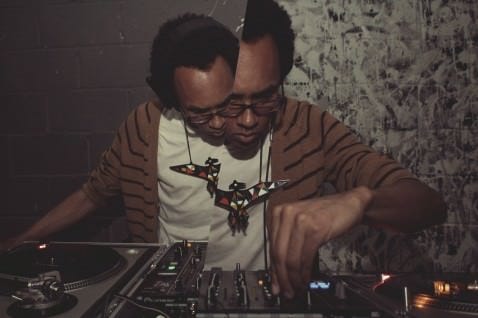
You’ve recently been appointed the director of graduate studies in the art school at Bard College. And one of the threads that runs through Uproot is the idea of people learning things for themselves: you talk about music discovery through mail-ordering catalogs, or about people teaching themselves Auto-Tune through YouTube videos. I’m fascinated by the play between formal and informal modes of learning. In what ways do you hope these informal modes, this autodidacticism, become an integral part of the university setting you’re in charge of?
What’s happening elsewhere is often further into the future with just less support. And the narrative around that is less formed, but it doesn’t mean it's not vital.
JC: Yeah, so much to say. At some level, it’s a book about following your curiosity and seeing where that goes. Being self-taught is part of it, but then also it’s about me being able to go into the world and being like, “What’s happening here? Why is this happening?” A baseline of deep curiosity as to what other people are doing, why this culture matters to them. Which, in many ways, it’s something I hope to inculcate in all the MFA students who go through the Bard program. Which is to say, “You're an artist, great, you’re doing your stuff. But also the world remains magical and mystifying.” This lifelong curiosity in things that are not your own work are so important, I think, to be a human and to be an artist. As far as [the] MFA [program] goes, it’s more in the line of something like Black Mountain College than it is, you know, Yale MFA or Columbia MFA, for example, which tend to have classes. It’s like a lot of talking, a lot of crit, a lot of one-on-one conferences.
Out of all these different places where I’ve taught, it’s actually the one that’s been most inspiring to me as a teacher. At some level, it’s just trying to sort out this basic question, which is like, “How can we help artists become better artists?” Which is a little bit like anarchist training, right? How do you do whatever it is that you want to do? How do you define success in that? To both try to not be programmatic about it because this is art [laughs], you know, this is about the newness and this is about unpredictability and surprise. But also to do it in a way which is repeatable and can be turned into something like a process or a series of processes.
BS: Yeah, it’s a question of how you lead something through what you described earlier as a messy landscape, helping them find a path through it while remaining open to what’s just to either side of that path …
JC: We’re in this amazing position where we can accept students who might not have traditional degrees. And we can also bring in people to teach who don’t have traditional degrees, you know? Which means we really can hire amazing, brilliant artists with deeply idiosyncratic brains—and they’re the best people for this. We can really foster this kind of wider conversation where it’s not just you in your studio, it’s you in your studio and then you and ninety people in a room talking about one piece of art for forty-five minutes. It happens across three summers and when you’re there it’s deeply intensive. We can play with time and intensity in all these fascinating ways. But to me—and when I say, having artists teaching artists, it’s people who were not properly formatted. And we end up being artists because of, like, a non-compliance. You’re like, “I don't fit here. I don’t fit there. I don’t fit there.” But here’s how I’ve put this together. It’s against experts, but very much for protecting quieter voices, protecting voices that are further from the center.
For me, that’s this kind of through line with so much I was writing about Uproot. Here we are in Morocco, here we are in Beirut, here we are in rural Mexico. Not being like, this is what’s going on in New York or let’s look at the artists who are already famous. I enjoyed you calling it prescient because what’s happening elsewhere is often further into the future with just less support. And the narrative around that is less formed, but it doesn’t mean it's not vital.
BS: As a final question, let’s return to the ideas of enthusiasm and optimism we discussed at the outset and take turns recommending a few records or releases that have come out this year and that you think people might be interested in hearing or that moved you. Do you want to go first?
JC: It’s funny that you ask. I can’t really recommend any music for you this year. I’m sure there’s lots of amazing music [being] made. I kind of spent this year making a ton of music. I’ve gotten down this whole modular synthesizer wormhole. About half a dozen years ago, I had some grant money and I had to spend it and I was able to get this very strange hardware called modular synths, with these little tiny units that do very simple things and then you kind of cobble them together with cables. And then, the simple behaviors can sort of ratchet up into really complex and organic and wild behaviors. I realized, “Oh, this is not just like a fancy vintage synthesizer, this is a whole different approach of getting in touch with the fundamentals of electronic music.” It is deeply non-hierarchical and based around, like, control voltages, fluctuating electricity—you know, analog waves. It’s a thrilling environment to work in.
And one of the most immediate impacts it had on me was … I was like, “Oh, this is fun as process. I just want to learn this and be in this sound.” And the axis of selection becomes secondary, the axis of like composition [laughs] becomes tertiary. It’s more about inhabiting this flow. This means that I’ve been a little checked out on listening to other people’s music [in] the last two years. It definitely happens, but I’m reluctant to recommend things. My long answer to a very good question.
BS: Well, I had wanted to return to optimism and excitement and hearing you talk about modular synths fits the bill, too. Computer programmers talk about getting “closer to the metal” the more you work with basic and fundamental computer architectures. Perhaps after twenty-five years of shaping other people’s sounds, and of making your own sounds with tools that others would recognize, you’re diving deeper, going toward the metal, toward the signals.
JC: Yeah. Absolutely.
BS: Thank you so much for this conversation, and for Uproot, and for holding on to your optimism in a cultural moment that can sometimes seem not worth being optimistic about.
JC: Wonderful. Thank you. It’s great conversation.
Thanks for listening to this episode of the Frontier Magazine podcast. It’s the audio component of our weekly publication, which features appreciations from the forefronts of architecture, technology, culture, and education. Each issue shares new ideas about how design and creativity accelerate positive change. Everything we publish is available for free; browse the archive and sign up for new issues at magazine.frontier.is. If you liked this episode, please share it with people you know and rate us to help others discover what we’re doing.
The magazine and podcast are products of Frontier, a design office in Toronto. Here’s studio founder Paddy Harrington:
Frontier is a design office. We believe in the expansive potential of storytelling to help people navigate the unknown to get somewhere new. We’re coming up on a decade of designing big stories in the form of strategies, brand identities, editorial products, and digital and real-world experiences that help organizations, brands, and individuals stand out and discover new creative territory. Learn more at frontier.is.
Thanks again. I hope you’ll join us for the next episode.


